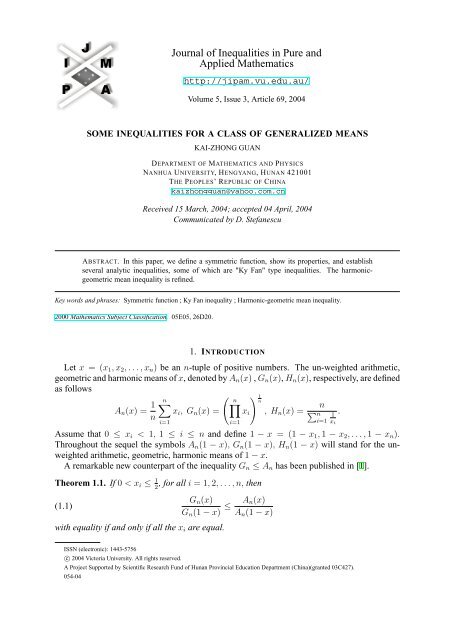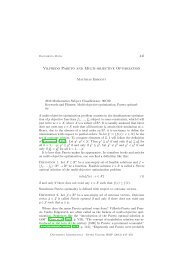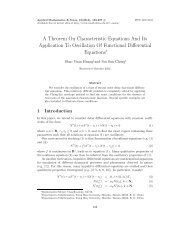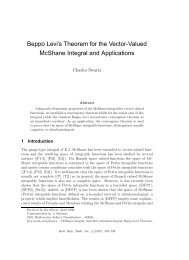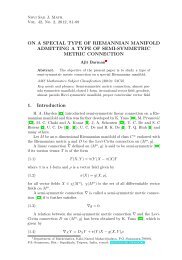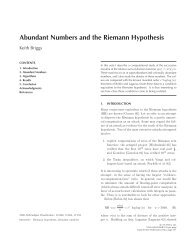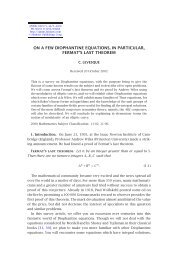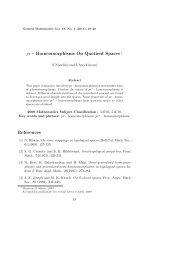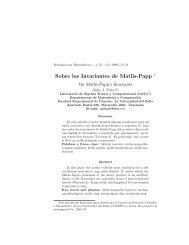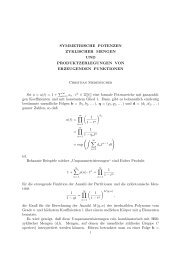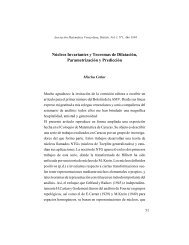Some Inequalities for a Class of Generalized Means
Some Inequalities for a Class of Generalized Means
Some Inequalities for a Class of Generalized Means
You also want an ePaper? Increase the reach of your titles
YUMPU automatically turns print PDFs into web optimized ePapers that Google loves.
Journal <strong>of</strong> <strong>Inequalities</strong> in Pure and<br />
Applied Mathematics<br />
http://jipam.vu.edu.au/<br />
Volume 5, Issue 3, Article 69, 2004<br />
SOME INEQUALITIES FOR A CLASS OF GENERALIZED MEANS<br />
KAI-ZHONG GUAN<br />
DEPARTMENT OF MATHEMATICS AND PHYSICS<br />
NANHUA UNIVERSITY, HENGYANG, HUNAN 421001<br />
THE PEOPLES’ REPUBLIC OF CHINA<br />
kaizhongguan@yahoo.com.cn<br />
Received 15 March, 2004; accepted 04 April, 2004<br />
Communicated by D. Stefanescu<br />
ABSTRACT. In this paper, we define a symmetric function, show its properties, and establish<br />
several analytic inequalities, some <strong>of</strong> which are "Ky Fan" type inequalities. The harmonicgeometric<br />
mean inequality is refined.<br />
Key words and phrases: Symmetric function ; Ky Fan inequality ; Harmonic-geometric mean inequality.<br />
2000 Mathematics Subject <strong>Class</strong>ification. 05E05, 26D20.<br />
1. INTRODUCTION<br />
Let x = (x1, x2, . . . , xn) be an n-tuple <strong>of</strong> positive numbers. The un-weighted arithmetic,<br />
geometric and harmonic means <strong>of</strong> x, denoted by An(x) , Gn(x), Hn(x), respectively, are defined<br />
as follows<br />
An(x) = 1<br />
n<br />
n<br />
<br />
n<br />
xi, Gn(x) =<br />
i=1<br />
i=1<br />
xi<br />
1<br />
n<br />
, Hn(x) =<br />
n<br />
n 1 .<br />
i=1 xi<br />
Assume that 0 ≤ xi < 1, 1 ≤ i ≤ n and define 1 − x = (1 − x1, 1 − x2, . . . , 1 − xn).<br />
Throughout the sequel the symbols An(1 − x), Gn(1 − x), Hn(1 − x) will stand <strong>for</strong> the unweighted<br />
arithmetic, geometric, harmonic means <strong>of</strong> 1 − x.<br />
A remarkable new counterpart <strong>of</strong> the inequality Gn ≤ An has been published in [1].<br />
Theorem 1.1. If 0 < xi ≤ 1,<br />
<strong>for</strong> all i = 1, 2, . . . , n, then<br />
2<br />
(1.1)<br />
Gn(x)<br />
Gn(1 − x)<br />
with equality if and only if all the xi are equal.<br />
ISSN (electronic): 1443-5756<br />
c○ 2004 Victoria University. All rights reserved.<br />
≤ An(x)<br />
An(1 − x)<br />
A Project Supported by Scientific Research Fund <strong>of</strong> Hunan Provincial Education Department (China)(granted 03C427).<br />
054-04
2 KAI-ZHONG GUAN<br />
This result, commonly referred to as the Ky Fan inequality, has stimulated the interest <strong>of</strong><br />
many researchers. New pro<strong>of</strong>s, improvements and generalizations <strong>of</strong> the inequality (1.1) have<br />
been found. For more details, interested readers can see [2], [3] and [4].<br />
W.-L. Wang and P.-F. Wang [5] have established a counterpart <strong>of</strong> the classical inequality<br />
Hn ≤ Gn ≤ An. Their result reads as follows.<br />
Theorem 1.2. If 0 < xi ≤ 1,<br />
<strong>for</strong> all i = 1, 2, . . . , n, then<br />
2<br />
(1.2)<br />
Hn(x)<br />
Hn(1 − x)<br />
≤ Gn(x)<br />
Gn(1 − x)<br />
≤ An(x)<br />
An(1 − x) .<br />
All kinds <strong>of</strong> means about numbers and their inequalities have stimulated the interest <strong>of</strong> many<br />
researchers. Here we define a new mean, that is:<br />
Definition 1.1. Let x ∈ Rn + = {x|x = (x1, x2, . . . , xn)|xi > 0, i = 1, 2, . . . , n}, we define the<br />
symmetric function as follows<br />
H r n(x) = H r <br />
r<br />
n(x1, x2, . . . , xn) =<br />
1≤i1 1) is called Schur-convex if x ≺ y, then<br />
(1.3) f(x) ≤ f(y)<br />
<strong>for</strong> all x, y ∈ I n = I ×I ×· · ·×I (n copies). It is called strictly Schur-convex if the inequality is<br />
strict; f is called Schur-concave (resp. strictly Schur-concave) if the inequality (1.3) is reversed.<br />
For more details, interested readers can see [6], [7] and [8].<br />
The paper is organized as follows. A refinement <strong>of</strong> harmonic-geometric mean inequality<br />
is obtained in Section 3. In Section 4, we investigate the Schur-convexity <strong>of</strong> the symmetric<br />
function. Several “Ky Fan” type inequalities are obtained in Section 5.<br />
2. LEMMAS<br />
In this section, we give the following lemmas <strong>for</strong> the pro<strong>of</strong>s <strong>of</strong> our main results.<br />
Lemma 2.1. ([5]) If 0 < xi ≤ 1<br />
2<br />
(2.1)<br />
n 1<br />
i=1 1−xi n 1<br />
i=1 xi<br />
≤<br />
, <strong>for</strong> all i = 1, 2, . . . , n, then<br />
1<br />
n 1 n<br />
i= 1−xi n 1<br />
i= xi<br />
or Hn(x)<br />
Hn(1 − x)<br />
≤ Gn(x)<br />
Gn(1 − x) .<br />
Lemma 2.2. If 0 < xi ≤ 1<br />
2 , <strong>for</strong> all i = 1, 2, . . . , n + 1, and Sn+1 = n+1 i=1<br />
n+1<br />
i=1<br />
(2.2)<br />
1 , then<br />
1−xi<br />
⎡<br />
⎣<br />
<br />
n+1<br />
i=1<br />
Sn+1 − 1<br />
n+1<br />
i=1<br />
<br />
1−xi<br />
Sn+1 − 1<br />
xi<br />
⎤n<br />
⎡<br />
<br />
n+1<br />
i=1<br />
Sn+1 −<br />
⎦ ≤ ⎣<br />
1<br />
⎤<br />
1−xi<br />
⎦<br />
n+1<br />
i=1<br />
Sn+1 − 1<br />
xi<br />
1<br />
n+1<br />
.<br />
1<br />
xi , Sn+1 =<br />
J. Inequal. Pure and Appl. Math., 5(3) Art. 69, 2004 http://jipam.vu.edu.au/
SOME INEQUALITIES FOR A CLASS OF GENERALIZED MEANS 3<br />
Pro<strong>of</strong>. Inequality (2.2) is equivalent to the following<br />
n ln Sn+1<br />
≤<br />
Sn+1<br />
1<br />
n + 1 ln<br />
⎡<br />
<br />
n+1<br />
i=1<br />
Sn+1 −<br />
⎣<br />
1<br />
<br />
1−xi<br />
n+1 i=1 (Sn+1 − 1<br />
xi )<br />
⎤<br />
⎦<br />
Since 0 < xi ≤ 1<br />
2 , and 1 − xi ≥ xi, it follows that<br />
Sn+1 − 1<br />
1−xj<br />
Sn+1 − 1<br />
xj<br />
=<br />
≥<br />
1<br />
1−x1<br />
+ · · · + 1<br />
1−xj−1<br />
1<br />
x1<br />
1<br />
1<br />
+ + · · · + 1−xj+1 1−xn+1<br />
1 1<br />
1<br />
+ · · · + + + · · · + xj−1 xj+1 xn+1<br />
1<br />
1−x1 · · · 1 1<br />
1−xj−1 1−xj+1 · · · 1<br />
1−xn+1<br />
1<br />
x1 · · · 1 1<br />
xj−1 xj+1 · · · 1 .<br />
xn+1<br />
By the above inequality and Lemma 2.1, we have<br />
1<br />
n + 1 ln<br />
n+1 Sn+1 −<br />
i=1<br />
1<br />
1−xi<br />
Sn+1 − 1 ≥<br />
xi<br />
1<br />
n + 1 ln<br />
n+1 <br />
<br />
1 1<br />
1 − xi xi<br />
i=1<br />
n+1 <br />
<br />
1 1<br />
= n ln<br />
1 − xi xi<br />
or<br />
n ln Sn+1<br />
Sn+1<br />
≥ n ln<br />
i=1<br />
1<br />
1−x1<br />
1<br />
x1<br />
n+1<br />
i=1<br />
+ · · · + 1<br />
1−xn+1<br />
+ · · · + 1<br />
xn+1<br />
≤ 1<br />
n + 1 ln<br />
⎡<br />
<br />
n+1<br />
i=1<br />
Sn+1 −<br />
⎣<br />
1<br />
⎤<br />
1−xi<br />
⎦ .<br />
Sn+1 − 1<br />
xi<br />
,<br />
n+1<br />
Lemma 2.3. [6, p. 259]. Let f(x) = f(x1, x2, . . . , xn) be symmetric and have continuous<br />
partial derivatives on I n , where I is an open interval. Then f : I n → R is Schur-convex if and<br />
only if<br />
(2.3)<br />
<br />
∂f<br />
(xi − xj)<br />
∂xi<br />
− ∂f<br />
<br />
≥ 0<br />
∂xj<br />
on I n . It is strictly Schur-convex if (2.3) is a strict inequality <strong>for</strong> xi = xj, 1 ≤ i, j ≤ n.<br />
Since f(x) is symmetric, Schur’s condition can be reduced as [7, p. 57]<br />
(2.4)<br />
<br />
∂f<br />
(x1 − x2)<br />
∂x1<br />
− ∂f<br />
<br />
≥ 0,<br />
∂x2<br />
and f is strictly Schur-convex if (2.4) is a strict inequality <strong>for</strong> x1 = x2. The Schur condition<br />
that guarantees a symmetric function being Schur-concave is the same as (2.3) or (2.4) except<br />
the direction <strong>of</strong> the inequality.<br />
In Schur’s condition, the domain <strong>of</strong> f(x) does not have to be a Cartesian product I n . Lemma<br />
2.3 remains true if we replace I n by a set A ⊆ R n with the following properties ([7, p. 57]):<br />
(i) A is convex and has a nonempty interior;<br />
(ii) A is symmetric in the sense that x ∈ A implies P x ∈ A <strong>for</strong> any n × n permutation<br />
matrix P .<br />
J. Inequal. Pure and Appl. Math., 5(3) Art. 69, 2004 http://jipam.vu.edu.au/<br />
n
4 KAI-ZHONG GUAN<br />
3. REFINEMENT OF THE HARMONIC-GEOMETRIC MEAN INEQUALITY<br />
The goal <strong>of</strong> this section is to obtain the basic inequality <strong>of</strong> H r n(x), and give a refinement <strong>of</strong><br />
the Harmonic-Geometric mean inequality.<br />
Theorem 3.1. Let x ∈ R n + = {x|x = (x1, x2, . . . , xn)|xi > 0, i = 1, 2, . . . , n}, then<br />
(3.1) H r+1<br />
n (x) ≤ H r n(x), r = 1, 2, . . . , n − 1.<br />
Pro<strong>of</strong>. By the arithmetic-geometric mean inequality and the monotonicity <strong>of</strong> the function y =<br />
ln x, we have<br />
<br />
n<br />
ln H<br />
r + 1<br />
r+1<br />
n (x) = r + 1<br />
ln r+1 Let<br />
Sj =<br />
=<br />
=<br />
≤<br />
=<br />
We can easily get<br />
n<br />
Sj = (n − r)<br />
j=1<br />
1≤i1
SOME INEQUALITIES FOR A CLASS OF GENERALIZED MEANS 5<br />
Remark 3.3. The corollary refines the harmonic-geometric mean inequality.<br />
4. SCHUR-CONVEXITY OF THE FUNCTION H r n(x)<br />
In this section, we investigate the Schur-convexity <strong>of</strong> the function H r n(x), and establish several<br />
analytic inequalities by use <strong>of</strong> the theory <strong>of</strong> majorization.<br />
Theorem 4.1. Let R n + = {x|x = (x1, x2, . . . , xn)|xi > 0, i = 1, 2, . . . , n}, then the function<br />
H r n(x) is Schur-concave in R n +.<br />
Pro<strong>of</strong>. It is clear that H r n(x) is symmetric and has continuous partial derivatives on R n +. By<br />
Lemma 2.3, we only need to prove<br />
As matter <strong>of</strong> fact, we can easily derive<br />
ln H r n(x) = 1<br />
<br />
n<br />
r<br />
r ∂H<br />
(x1 − x2)<br />
n(x)<br />
−<br />
∂x1<br />
∂Hr <br />
n(x)<br />
≤ 0.<br />
∂x2<br />
<br />
2≤i1
6 KAI-ZHONG GUAN<br />
Thus<br />
r ∂H<br />
(x1 − x2)<br />
n(x)<br />
−<br />
∂x1<br />
∂Hr <br />
n(x)<br />
∂x2<br />
= (x1 − x2) Hr ⎡⎛<br />
n(x)<br />
⎣⎝<br />
<br />
− ⎝<br />
+<br />
⎛<br />
= −(x1 − x2) 2<br />
≤ 0.<br />
+<br />
n<br />
r<br />
<br />
2≤i1
Pro<strong>of</strong>. By [9], we have<br />
c − x<br />
nc − s =<br />
Using Theorem 4.1, we obtain<br />
or<br />
SOME INEQUALITIES FOR A CLASS OF GENERALIZED MEANS 7<br />
<br />
c − x1 c − xn<br />
, . . . , ≺<br />
nc − s nc − s<br />
H r n<br />
<br />
c − x<br />
≥ H<br />
nc − s<br />
r n<br />
H r n(c − x)<br />
H r n(x)<br />
Remark 4.4. Let c = s = 1, we can obtain<br />
In particular,<br />
H r n(1 − x)<br />
H r n(x)<br />
Hn(1 − x)<br />
Hn(x)<br />
≥<br />
nc<br />
s<br />
x1<br />
s<br />
<br />
x<br />
<br />
,<br />
s<br />
1<br />
(<br />
− 1<br />
n r ) .<br />
<br />
xn<br />
, . . . , =<br />
s<br />
x<br />
s .<br />
1<br />
≥ (n − 1) ( n r ) , r = 1, 2, . . . , n.<br />
≥ (n − 1),<br />
Gn(1 − x)<br />
Gn(x) ≥ n√ n − 1.<br />
5. SOME “KY FAN” TYPE INEQUALITIES<br />
In this section, some “Ky Fan” type inequalities are established, the Ky Fan inequality is<br />
generalized.<br />
Theorem 5.1. Assume that 0 < xi ≤ 1<br />
2<br />
(5.1)<br />
Pro<strong>of</strong>. Set<br />
Hr+1 n (x)<br />
Hr+1 n (1 − x) ≤<br />
r Hn(x) Hr n(1 − x)<br />
ϕr = Hr n(x)<br />
H r n(1 − x) =<br />
, i = 1, 2, . . . , n, then<br />
<br />
1≤i1
8 KAI-ZHONG GUAN<br />
Similar to Theorem 3.1, we can derive<br />
Thus<br />
or<br />
n<br />
r + 1<br />
<br />
ln φr+1 ≤<br />
1<br />
(n − r)<br />
r(r + 1)<br />
(φr) 1<br />
r ≥ φr+1,<br />
<br />
n<br />
<br />
ln φr =<br />
r<br />
1<br />
<br />
n<br />
ln φr.<br />
r r + 1<br />
Hr+1 n (x)<br />
Hr+1 n (1 − x) ≤<br />
r Hn(x) Hr 1<br />
r<br />
, r = 1, 2, . . . , n − 1.<br />
n(1 − x)<br />
Remark 5.2. By Theorem 5.1, we can obtain<br />
(5.2)<br />
H 2 n(x)<br />
H 2 n(1 − x) ≤ H1 n(x)<br />
H 1 n(1 − x)<br />
This is a generalization <strong>of</strong> the “Ky Fan” inequality.<br />
= Gn(x)<br />
Gn(1 − x)<br />
≤ An(x)<br />
An(1 − x) .<br />
By Lemma 2.1 and the pro<strong>of</strong> <strong>of</strong> Theorem 3.1, we have the following<br />
Theorem 5.3. If 0 < xi ≤ 1<br />
2<br />
(5.3)<br />
n<br />
i=1 (xi)<br />
n<br />
i=1<br />
, i = 1, 2, . . . , n, then<br />
Hn(x)<br />
≤<br />
(1 − xi) Hn(1 − x)<br />
The inequality (5.3) generalizes the inequality (1.2).<br />
Theorem 5.4. If 0 < xi ≤ 1,<br />
i = 1, 2, . . . , n, then<br />
2<br />
(5.4)<br />
Pro<strong>of</strong>. Set<br />
Hr n(x)<br />
Hr n(1 − x) ≤ H1 n(x)<br />
H1 n(1 − x)<br />
ϕr = Hr n(x)<br />
H r n(1 − x) =<br />
= Gn(x)<br />
Gn(1 − x)<br />
<br />
1≤i1
SOME INEQUALITIES FOR A CLASS OF GENERALIZED MEANS 9<br />
By knowledge <strong>of</strong> combination, we can easily find<br />
<br />
n<br />
<br />
ln φr ≤<br />
r<br />
1<br />
r ln<br />
<br />
n<br />
n−1<br />
1 ( r−1 )<br />
1−xi<br />
1<br />
i=1 xi<br />
= 1<br />
<br />
n<br />
<br />
1<br />
n − 1<br />
1−xi ln 1<br />
r r − 1<br />
i=1 xi<br />
= 1<br />
<br />
n − 1<br />
<br />
n<br />
<br />
ln φ1 = ln φ1.<br />
r r − 1<br />
r<br />
Thus<br />
φr ≤ φ1, r = 2, . . . , n,<br />
or<br />
H<br />
(5.5)<br />
r n(x)<br />
Hr Gn(x)<br />
≤ , r = 2, . . . , n.<br />
n(1 − x) Gn(1 − x)<br />
The inequality (5.5) generalizes the “Ky Fan” inequality.<br />
REFERENCES<br />
[1] E.F. BECKENBACH AND R. BELLMAN, <strong>Inequalities</strong>, Springer-Verlag, New York, 1965.<br />
[2] H. ALZER, The inequality <strong>of</strong> Ky Fan and related results, Acta. Appl. Math., 38 (1995), 305–354.<br />
[3] J. SÁNDOR, On an inequaliy <strong>of</strong> Ky Fan, Babe¸s-Bolyai Univ., Fac. Math. Phys., Res. Semin., 7<br />
(1990), 29–34.<br />
[4] J. SÁNDOR AND T. TRIF, A new refinement <strong>of</strong> the Ky Fan inequality, Math. Inequal. Appl., 2<br />
(1999), 529–533.<br />
[5] W.-L. WANG AND P.-F. WANG, A class <strong>of</strong> inequalities <strong>for</strong> symmetric functions (in chinese), Acta.<br />
Math .Sinica, 27 (1984), 485–497.<br />
[6] A.W. ROBERTS AND D.E. VARBERG, Convex Function, Academic Press, New York, San Francisco,<br />
London, 1973.<br />
[7] A.W. MARSHALL AND I. OLKIN, <strong>Inequalities</strong>: Theory <strong>of</strong> Majorization and Its Applications, Academic<br />
Press, 1979.<br />
[8] D.S. MITRINOVIĆ, Analytic <strong>Inequalities</strong>, Springer-Verlag, New York, 1970.<br />
[9] HUANNAN SHI, Refinement and generalization <strong>of</strong> a class <strong>of</strong> inequalities <strong>for</strong> symmetric functions<br />
(in Chinese), Mathematics in Practices and Theory, 4 (1999), 81–84.<br />
J. Inequal. Pure and Appl. Math., 5(3) Art. 69, 2004 http://jipam.vu.edu.au/


